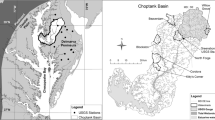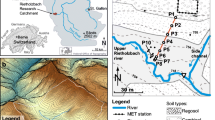Abstract
Seasonal runoff generation in a headwater (~100 km2) of the mountainous Sugnugr Basin, situated within the discontinuous permafrost zone of northern Mongolia, was investigated. The role of the active layer and the effects of a recent wildfire on runoff generation were elucidated. On the catchment scale, stormflow events were investigated by streamflow hydrograph analysis and stable isotope investigations. Hydrological response parameters indicate increasing recession periods and delayed flow fractions during summer as active layer thickness increases. Isotopic signature revealed a high ratio of meltwater in river baseflow in early summer and a gradual decline until the beginning of September. During a stormflow event in early summer, a high fraction of event water was determined by two-component hydrograph separation. At a taiga-vegetated hillslope, subsurface flow was observed following precipitation events after a relative increase in upper soil volumetric water content (VWC i ) of 0.05 m3 m−3, demonstrating the retarding characteristics of the organic surface layer. Depending on active layer depth, subsurface flow predominantly occurred in the organic surface layer in early summer and subsequently subsided into the underlying mineral layer as soils thawed. After a wildfire, the water retention capacity of the organic surface layer diminished, as was reflected by a VWC i of 0.01 m3 m−3. Here, stormflow water temperatures indicated quickflow in the mineral layer above a degenerated frost table. The results of the study suggest that wildfires increase stormflow runoff while baseflow declines. Hence, the problem of water shortages in downstream areas during dry weather conditions is exacerbated.






Similar content being viewed by others
References
Boucher JL, Carey SK (2010) Exploring runoff processes using chemical, isotopic and hydrometric data in a discontinuous permafrost catchment. Hydrol Res 41:508–519. doi:10.2166/nh.2010.146
Carey SK, Quinton WL (2005) Evaluating runoff generation during summer using hydrometric, stable isotope and hydrochemical methods in a discontinuous permafrost alpine catchment. Hydrol Process 19:95–114. doi:10.1002/hyp.5764
Carey SK, Woo MK (2000) The role of soil pipes as a slope runoff mechanism, Subarctic Yukon, Canada. J Hydrol 233:206–222222. doi:10.1016/S0022-1694(00)00234-1
Carey SK, Woo MK (2001a) Spatial variability of hillslope water balance, wolf creek basin, subarctic yukon. Hydrol Process 15:3113–3132. doi:10.1002/hyp.319
Carey SK, Woo MK (2001b) Slope runoff processes and flow generation in a subarctic, subalpine catchment. J Hydrol 253:110–129. doi:10.1016/S0022-1694(01)00478-4
Davi N, Jacoby G, Fang K, Li J, D’Arrigo R, Baatarbileg N, Robinson D (2010) Reconstructed drought across Mongolia based on a large-scale network of tree ring records 1693-1993. J Geophys Res 15:D22103. doi:10.1029/2010JD013907
Davi N, Pederson N, Leland C, Nachin B, Suran B, Jacoby GC (2013) Is eastern Mongolia drying? A long-term perspective of a multidecadal trend. Water Resour Res 49:151–158. doi:10.1029/2012WR011834
DeBano LF (2000) The role of fire and soil heating on water repellency in wildland environments: a review. J Hydrol 231–232:195–206. doi:10.1016/S0022-1694(00)00194-3
Dulamsuren C, Hauck M (2008) Spatial and seasonal variation of climate on steppe slopes of the northern Mongolian Taiga. Grassl Sci 54:217–230. doi:10.1111/j.1744-697X.2008.00128.x
Dulamsuren C, Hauck M, Mühlenberg M (2005) Ground vegetation in the Mongolian taiga forest-steppe ecotone does not offer evidence for the human origin of grasslands. Appl Veg Sci 8:149–154. doi:10.1111/j.1654-109X.2005.tb00640.x
Genereux D (1998) Quantifying uncertainty in tracer-based hydrograph separations. Water Resour Res 34:915–919
Goldammer JG (2002) Fire situation in Mongolia. Int For Fire News 26(75):83
Hessl AE, Ariya U, Brown P, Byambasuren O, Green T, Jacoby G, Kennedy Sutherland E, Nachin B, Stockton Maxwell R, Pederson N, De Grandpré L, Saladyga T, Tardif JC (2012) Reconstructing fire history in central Mongolia from tree-rings. Int J Wildland Fire 21(1):86–92. doi:10.1071/WF10108
Hinzman LD, Fukuda M, Sandberg DV, Chapin FS III, Dash D (2003) FROSTFIRE: an experimental approach to predicting the climate feedbacks from the changing boreal fire regime. J Geophys Res 108(D1):8153. doi:10.1029/2001JD000415
Hofmann J, Karthe D, Ibisch R, Schäffer M, Kaus A, Avlyush S, Heldt S (2015) Initial characterization and water quality assessment of stream landscapes in Northern Mongolia and its integration into a river basin management plan. Water 7(7):3166–3205. doi:10.3390/w7073166
Hülsmann L, Geyer T, Schweitzer C, Priess J, Karthe D (2015) The effect of subarctic conditions on water resources: initial results and limitations of the SWAT model applied to the Kharaa River catchment in Northern Mongolia. Environ Earth Sci 73(2):581–592. doi:10.1007/s12665-014-3173-1
Ishikawa M, Sharkhuu N, Zhang Y, Kadota T, Ohata T (2005) Ground thermal and moisture conditions at the southern boundary of discontinuous permafrost, Mongolia. Permafr Periglac 16:209–216. doi:10.1002/ppp.483
Johnson D, Oyunsanaa B, Myers RL, Babler M (2009) Fire management assessment of the eastern steppe, Mongolia. GFI technical report. The Nature Conservancy, Arlington
Karthe D, Hofmann J, Ibisch R, Heldt S, Westphal K, Menzel L, Avlyush S, Malsy M (2015) Science-based IWRM implementation in a data-scarce central asian region: experiences from a research and development project in the Kharaa River Basin, Mongolia. Water 7:3486–3514. doi:10.3390/w7073486
Kopp BJ, Minderlein S, Menzel L (2014) Effect of exposition, vegetation and wildfire on soil moisture distribution in a mountainous headwater area in the discontinuous permafrost zone of northern Mongolia. Arct Antarct Alp Res 46:459–470. doi:10.1657/1938-4246-46.2.459
Lange J, Haensler A (2012) Runoff generation following a prolonged dry period. J Hydrol 464–465:157–164. doi:10.1016/j.jhydrol.2012.07.010
Lange J, Kopp BJ, Bents M, Menzel L (2015) Tracer-hydrological process investigations on two opposite slopes in a mountainous, semi-arid, permafrost environment, northeastern Mongolia. Hydrol Process 29:1046–1055. doi:10.1002/hyp.v29.6
Leibundgut C, Maloszewski P, Külls C (2009) Tracers in hydrology. Wiley, Hoboken
Maillet E (1905) Essais d’hydraulique souterraine et fluvial. Librairie science. A. Hermann, Paris
Menzel L, Hofmann J, Ibisch R (2011) Studies of water and mass fluxes to provide a basis for an Integrated Water Resources Management (IWRM) in the catchment of the River Kharaa in Mongolia. Hydrol Wasserbewirtsch 55(2):88–103
Minderlein S, Menzel L (2015) Evapotranspiration and energy balance dynamics of a semi arid mountainous steppe and shrubland site in northern Mongolia. Environ Earth Sci 73(2):593–609. doi:10.1007/s12665-014-3335-1
Nyamjav B, Goldammer JG, Uibrig H (2007) The forest fire situation in Mongolia. Int For Fire News 36:46–66
Onodera SI, van Stan JT (2011) Effect of forest fires on hydrology and biogeochemistry of watersheds. In: Levia DF, Carlyle-Moses D, Tanakas T (eds) Forest hydrology and biogeochemistry. Springer, Dordrecht, pp 599–621
Osterkamp TE (2007) Characteristics of the recent warming of permafrost in Alaska. J Geophys Res 112:F02S02. doi:10.1029/2006JF000578
Pederson N, Leland C, Nachin B, Hessl AE, Bell AR, Martin-Benito D, Saladyga T, Suran B, Brown PM, Davi NK (2013) Three centuries of shifting hydrolimatic regimes across the Mongolian Breadbasket. Agric For Meteorol 178–179:10–20. doi:10.1016/j.agrformet.2012.07.003
Petrone KC, Hinzman LD, Shibata H, Jones JB, Boone RD (2007) The influence of fire and permafrost on sub-arctic stream chemistry during storms. Hydrol Process 21:423–434. doi:10.1002/hyp.6247
Priess JA, Schweitzer C, Wimmer F, Batkhishig O, Mimler M (2011) The consequences of land-use change and water demands in Central Mongolia. Land Use Policy 28:4–10. doi:10.1002/hyp.6247
Schulze ED, Wirth C, Mollicone D, Ziegler W (2005) Succession after stand replacing disturbances by fire, wind throw, and insects in the dark taiga of central Siberia. Oecologia 146:77–88. doi:10.1007/s00442-005-0173-6
Shur YL, Jorgenson MT (2007) Patterns of permafrost and degradation in relation to climate and ecosystems. Permafrost Periglac 18:7–19. doi:10.1002/ppp.582
Sklash MG, Farvolden RN (1979) The role of groundwater in storm runoff. J Hydrol 43:45–66. doi:10.1016/0022-1694(79)90164-1
Takata K (2002) Sensitivity of land surface processes to frozen soil permeability and surface water storage. Hydrol Process 16:2155–2172. doi:10.1002/hyp.1148
Tchebakova NM, Parfenova E, Soja AJ (2009) The effects of climate, permafrost and fire on vegetation change in Siberia in a changing climate. Environ Res Lett 4:045013. doi:10.1088/1748-9326/4/4/045013
Törnqvist R, Jarsjö J, Pietroń J, Bring A, Rogberg P, Asokan SM, Destouni G (2014) Evolution of the hydro-climate system in the Lake Baikal basin. J Hydrol 519(B):1953–1962. doi:10.1016/j.jhydrol.2014.09.074
Tsujimura M, Abe Y, Tanaka T, Shimada J, Higuchi S, Yamanaka T, Davaa G, Oyunbaatar D (2007) Stable isotopic and geochemical characteristics of groundwater in Kherlen River basin, a semi-arid region in eastern Mongolia. J Hydrol 333:47–57. doi:10.1016/j.jhydrol.2006.07.026
Woo MK, Kane DL, Carey SK, Yang D (2008) Progress in permafrost hydrology in the new millennium. Permafrost Periglac 19:237–254. doi:10.1002/ppp.613
Wright N, Hayashi M, Quinton WL (2009) Spatial and temporal variations in active layer thawing and their implication on runoff generation in peat-covered permafrost terrain. Water Resour Res 45:W05414. doi:10.1029/2008WR006880
Yamazaki Y, Kubota J, Ohata T, Vuglinsky T, Mizuyama T (2006) Seasonal changes in runoff characteristics on a permafrost watershed in the southern mountainous region of eastern Siberia. Hydrol Process 20:453–467. doi:10.1002/hyp.5914
Yoshikawa K, Bolton WR, Romanovsky VE, Fukuda M, Hinzman LD (2002) Impacts of wildfire on the permafrost in the boreal forests of Interior Alaska. J Geophys Res 107:8148. doi:10.1029/2001JD000438
Zhao L, Wu Q, Marchenko SS, Sharkhuu N (2010) Thermal state of permafrost and active layer in central asia during the international polar year. Permafrost Periglac 21(2):198–207. doi:10.1002/ppp.688
Acknowledgments
This work was funded by a research grant of the German Federal Ministry of Education and Research (BMBF) to the project MoMo (Integrated Water Resources Management in Central Asia—Model Region Mongolia, FKZ: 033L003C) to Prof. Dr. L. Menzel. The authors would like to thank Stefanie Minderlein and Mathias Bents for help during field work and Barbara Herbstritt for assistance in the laboratory. We further thank Chimegsaikhan Altangerel, Nasanbayar Narantsogt, Khuhuu Gunsenbat and Nugonhayaar Gansukh for their support of this study. We further thank two anonymous reviewers and the editors, who certainly helped to improve this manuscript.
Author information
Authors and Affiliations
Corresponding author
Electronic supplementary material
Below is the link to the electronic supplementary material.
Fig. 1
Supplementary Material: Schematic scheme showing the position of the active layer above the frost table and the dominant runoff pathways during stormflow in the taiga in early (a) and late summer (b) and in the burned taiga in early (c) and late summer (d) (TIFF 11572 kb)
Rights and permissions
About this article
Cite this article
Kopp, B.J., Lange, J. & Menzel, L. Effects of wildfire on runoff generating processes in northern Mongolia. Reg Environ Change 17, 1951–1963 (2017). https://doi.org/10.1007/s10113-016-0962-y
Received:
Accepted:
Published:
Issue Date:
DOI: https://doi.org/10.1007/s10113-016-0962-y




